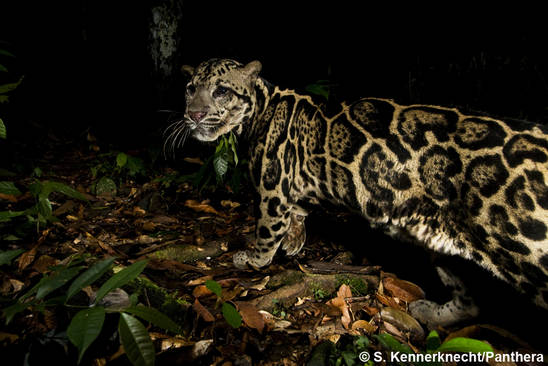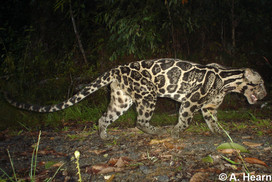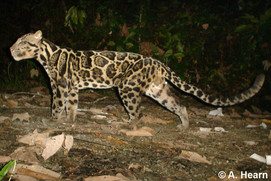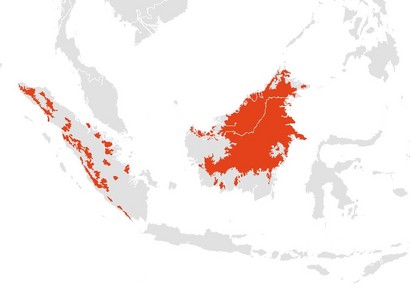Sunda clouded leopard
Neofelis diardi
IUCN Red List: Vulnerable
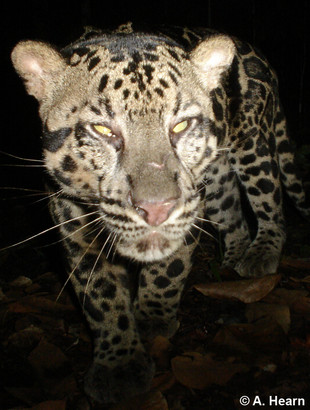
| Weight: | 11-25 kg |
| Body length: | 69-108 cm |
| Tail length: | 61-91 cm |
| Longevity: | average 11, up to 17 years |
| Litter size: | 1-2 cubs |

Description
The Sunda clouded leopard (Neofelis diardi) belongs to the subfamily Pantherinae. It was only recently recognized as a distinct species and distinguished from its mainland relative, the Mainland clouded leopard (Neofelis nebulosa), based on mitochondrial DNA, microsatellites, chromosomal differences and pelage morphology. Approximately 1.4 – 2.9 million years of isolated development have led to a degree of kinship between N. nebulosa and N. diardi that is comparable to the kinship between jaguar (Panthera onca) and leopard (Panthera pardus). The Sunda clouded leopard was previously considered one of four subspecies of Neofelis nebulosa. Two subspecies of N. diardi have been recognised based on genetic differences:
- Neofelis diardi diardi inhabiting Sumatra and Batu Islands and
- Neofelis diardi borneensis occurring on Borneo
N. diardi has smaller markings and greyer fur than N. nebulosa. Its greyish coat has cloud-like patterns that are of darker colour than the background. This special coat pattern and the region where it occurs (Sundaland or Sunda region refers to the islands of Sumatra, Borneo, Java, Bali and the Malayan Peninsula) give the Sunda clouded leopard its name. Black and also pale whitish animals have been reported from Borneo, but these colour morphs have not been recorded by the increasingly intense camera trap surveys across the island. The limbs of the Sunda clouded leopard are relatively short and marked with black spots. Its tail is very long (76-88% of the head-body length) with black spots and rings towards the tip. Male’s tails are typically long and slender, but females tend to have quite fluffy tails. Its canines are, as for N. nebulosa, very long in relation to the skull size, longer than for any other extant felid species (except N. nebulosa). Its long tail and short legs enable it to move easily in the trees. The Sunda clouded leopard is the largest felid inhabiting Borneo.
Language/Country | Name |
|---|---|
English | enkuli clouded leopard, Diard's clouded leopard, Sunda Island clouded leopard, Sundaland clouded leopard |
Brunei (Iban) | engkuli |
Indonesia | macan dahan |
Malaysia (Iban) | harimau dahan; engkuli |
Status and Distribution
The Sunda clouded leopard is classified as Vulnerable on the IUCN Red List with a decreasing population; both subspecies of the Sunda clouded leopard are classified as Endangered on the IUCN Red List. Since its ecology, abundance, population dynamics and conservation status are not well understood, it remains unclear how reliable these designations are.
The subspecies N. d. diardi is thought to have a fragmented population with low density; likewise N. d. borneensis is also believed to exist at a low density. The number of mature individuals of the species is suggested to be around 4,500 animals extrapolating a mean density of 1 / 100 km² across its AOO. Population density of Sunda clouded leopard range from 0.8 to 4.4 individuals / 100 km².
Study area | Density / 100 km² |
|---|---|
Borneo | |
Crocker Range National Park | 1.4 |
Danum Valley Conservation Area | 1.76 |
Maliau Basin Conservation Area | 0.8 |
Sabangau peat swamp forest | 0.72-4.41 |
Segaliud Lokan Forest Reserve | 1.04 |
Tabin Wildlife Reserve | 2.26 |
Tangkulap-Pinangah Forest Reserve | 0.84 |
Tawau Hills National Park | 1.85 |
Ulu Segama Forest Reserve | 2.55 |
Wehea Forest | 1.23-3.01 |
Sumatra | |
Bukit Tigapuluh Conservation Landscape | 1.2 |
Kerinci landscape | 0.8-1.6 |
Estimated population sizes to date are relatively low. A study in 2006 estimated there to be 1,500-3,200 Sunda clouded leopards in Sabah (Borneo, Malaysia), although it is now generally accepted that this figure is derived from an overestimated density estimate. It is suggested that range-wide around 4,500 mature individuals exist, with 3,800 animals persisting in Borneo and 730 in Sumatra.
The Sunda clouded leopard is found in Brunei, Indonesia (Borneo and Sumatra) and Malaysia (Sabah, Sarawak). Malaysia is the only country which contains both species of clouded leopard. The Sunda clouded leopard is restricted to the islands of Borneo and Sumatra. In Sabah, it is thought to occur in most protected areas. It is unknown whether the Sunda clouded leopard also occurs on the Batu Islands near Sumatra. On Java, fossils of clouded leopards have been found, but it has possibly been extinct there since the Holocene.
Habitat
Like the Mainland clouded leopard, the Sunda clouded leopard appears to be forest dependent, but exhibits a relatively high degree of habitat plasticity. It is found in primary lowland and hill dipterocarp and submontane forest, but has also been recorded in logged areas, mangroves and peat swamp forests. It does not readily use oil palm plantations.
On Sumatra, the Sunda clouded leopard seems to be more abundant in hilly, mountain areas than at lower elevations. On Borneo, it also inhabits lowland rainforest, possibly due to the fact that there are no tigers on Borneo, which perhaps prefer the lower elevations on Sumatra. Sunda clouded leopards have been recorded at 1,500 m a.s.l on Gunung Dulit in Sarawak and at 1,452 m a.s.l. in Crocker Range National Park in Sabah.

- Habitat of the Sunda clouded leopard, Malaysia.
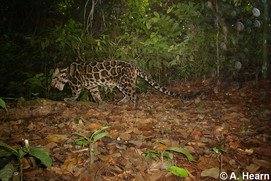
- Sunda clouded leopard in its typical habitat.
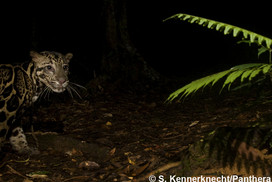
- Camera trap picture of a Sunda clouded leopard, Malaysia.

- Sunda clouded leopard camera trap picture, Malaysia.
Ecology and Behaviour
Very little information about the ecology and behaviour of the Sunda clouded leopard is available. It seems to be solitary and to be active mostly at night and during the crepuscular hours, but can also be active during the day. Like the Mainland clouded leopard, the Sunda clouded leopard is an excellent climber; it moves easily through trees where it has been observed hunting primates. Sunda clouded leopards are also known to travel along forest trails and logging roads. It has been suggested that they travel extensively on the ground and may be less arboreal than previously thought. It has been speculated that Sunda clouded leopards on Borneo may be less arboreal than on Sumatra where tigers also occur. More behaviour studies are clearly needed.
Up to now only four Sunda clouded leopards have been radio or GPS-collared (one female and three males). The home range of a female in a selectively logged forest in Sabah, over a 109 day period was 16.1 km², with a core area of 5.4 km². The home range of a male Sunda clouded leopard estimated by a camera trap study exceeded 45 km².
The birth season is not known.
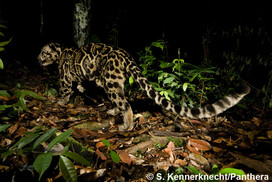
- Camera trap picture of a Sunda clouded leopard, Malaysia.

- Male Sunda clouded leopard, Malaysia.
Prey
The Sunda clouded leopard preys on a variety of arboreal and terrestrial species, although the relative importance of each in its diet remains unknown. It has been observed hunting proboscis monkeys, siamang and long-tailed macaques, and anecdotal evidence suggests it preys on grey leaf monkeys, porcupines, bearded pigs, muntjacs, sambar deer, mouse deer, common palm civets, fish and great Argus pheasants. There are records of Sunda clouded leopards preying on orangutans on Borneo. Occasionally it takes livestock such as goats and chickens.
Main Threats
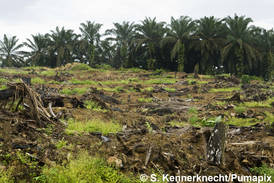
- Oil Palm (Elaeis guineensis) plantation and clear cut for new planting, Sabah, Borneo, Malaysia.
The major threat to the Sunda clouded leopard is habitat loss. Sumatra and Borneo have very high deforestation rates. It has been estimated that approximately 30% of the Sunda clouded leopard's forest range has been lost over the past 10 years, mostly due to clearance for settlements, oil palm plantations and other agricultural purposes. Malaysia and Indonesia are two of the world’s largest palm oil producers. The situation seems to be of particular concern on Sumatra where already up to 80% of prime rainforest has been felled.
Another threat is illegal trade. Sunda clouded leopard skins and body parts have high commercial value in the Asian medicinal trade, although it is not known how widespread this trade is. Sunda clouded leopards are culturally important at a local level and its skins are found in ceremonial clothes in some regions. In addition to being directly targeted, in some areas snares set for other species pose perhaps the greatest threat. Sunda clouded leopards sometimes prey on livestock which can lead to retaliation killing by local people, but it appears that such depredations are rare and it is not widely considered a pest by local people throughout its range. In some parts of its range, the prey base is overhunted with consequent negative impacts for the Sunda clouded leopard.
A constraint for effective conservation measurements is the lack of sufficient knowledge about the Sunda clouded leopard.
Conservation Efforts and Protection Status
The Sunda clouded leopard is currently included as Neofelis nebulosa in the Appendix I of CITES. It is fully protected in Indonesia, Malaysia and Brunei.
Recent efforts from Borneo helped and are continuing to increase the knowledge about the Sunda clouded leopard. One programme in Borneo combined capacity building with public awareness and conservation initiatives based on local input.
Further research is still needed to better understand the ecology, distribution and status of the Sunda clouded leopard. Sunda clouded leopard density seems to vary considerably across a relatively small spatial scale. It is important to know which habitat types the species uses and which landscape features present barriers to their movements and dispersal, a question that is currently being explored on Borneo. Another important point is the protection of and research into the prey species of the Sunda clouded leopard.
No single protected area is currently big enough to permanently sustain a viable population of Sunda clouded leopards. It is therefore essential to maintain suitable habitat corridors and connect isolated areas with one another to allow gene flow between otherwise isolated subpopulations.
Successful conservation efforts require that habitat destruction and poaching activity is prevented, public awareness is increased and law implementation is enforced.
